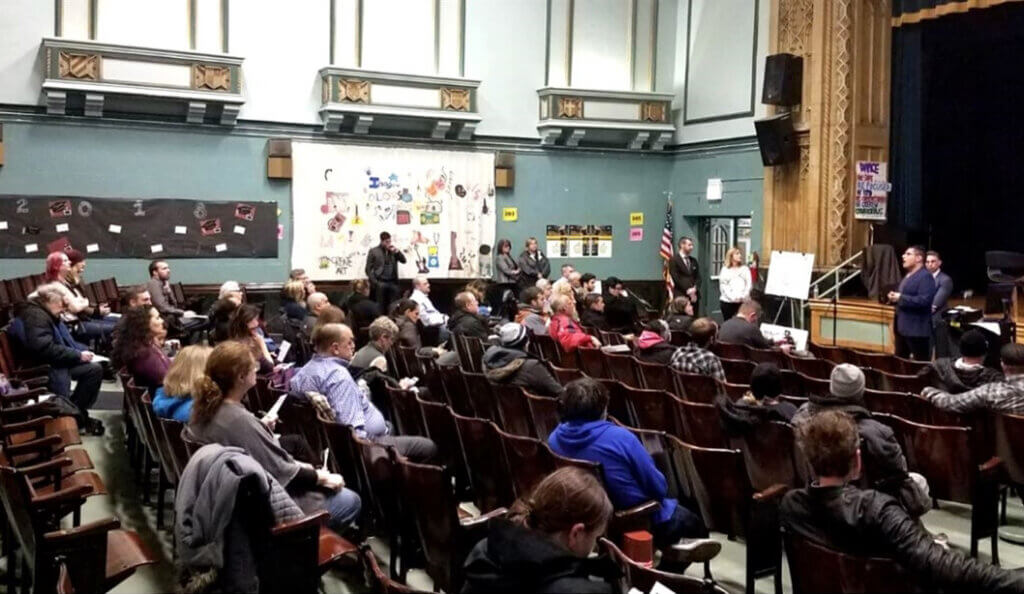Exploring zoning-related public engagement | Part 1/2
Public and community meetings

Community-driven participatory zoning meeting for Chicago’s 35th Ward held at a local school.
Photo: Local Progress
MPC and the Urban Institute are conducting research on how zoning and land use impact Chicago’s neighborhoods and residents from an equity, sustainability, and public health perspective. During the research process, we will be sharing what we learn and why it matters through a blog series. This blog is the second one and provides an introduction on the zoning process and public meetings.
To find out more about this project and stay up to date on progress check out our webpage.
Meetings: A key part of the zoning process
Through the Zoning and Land Use Assessment, MPC and the Urban Institute want to better understand the impact of zoning on public health, equity and sustainability in Chicago. One aspect of zoning is policy: the map and ordinance (“text”) that govern what can be built and where. Another is the process the City uses to apply the zoning rules and decide when to make exceptions. While measuring the impact of zoning policy is important, we can’t ignore the process: these formal and informal practices shape how Chicago grows and changes over time, and who can weigh in along the way.
A key part of the zoning process is public input—the ways residents and community members learn about a zoning decision, express their perspective, and potentially affect the outcome, often during meetings that are open to the public. But how does this work in Chicago? To help untangle the knotty topic of public engagement in the zoning process, MPC gathered research on the landscape of public input settings in Chicago.
A complex system of public input opportunities
In Chicago, the sheer number of decision-makers involved in zoning — each with their own level of discretion and procedures for collecting public input—can be dizzying. Depending on the type of proposal, even a re-zoning of a single property could be discussed in a host of meetings.
For example, a single proposal could pass through one or more ward-based community meetings (in Chicago, alderpeople hold substantial influence over zoning decisions in their ward), Chicago Plan Commission meetings, and City Council Committee on Zoning, Landmarks, and Buildings Standards meetings, before finally coming to a vote in a full City Council meeting. The number and order of these meetings would depend on the type of zoning change being considered. While each of these meetings would offer an opportunity for public comment, the process would be different in each one. The meetings would be organized separately, each taking place at a different time and place and promoted through different channels.
Understanding the landscape of zoning meetings in Chicago
We can think about the meetings in which residents and community members can provide input into Chicago’s zoning process in two categories.
Public meetings
Some meetings are officially designated as public meetings under the Illinois Open Meetings Act, the state law that gives members of the public the right to attend government meetings and share their opinions on public matters. Public hearings, formal legal proceedings that take place on the record and are required for certain zoning changes, must take place during a public meeting. What counts as a “public meeting”? In short, any gathering of a group (a “public body”) that meets to discuss public business. This group can be legislative, executive, administrative, or advisory, and it includes any group that’s supported by tax revenue. (One major exception is the state legislature.) A certain share of members must be present, usually a majority of a quorum.

What sets public meetings apart? There are minimum standards for transparency and engagement. Public meetings must be announced and their agenda published at least 48 hours in advance, and minutes must be published after the meeting. There must be an opportunity for public comment, though the Act does not specify what this should look like; each group sets its own rules. In a City Council meeting, for example, commenters are chosen by lottery and allowed three minutes each to speak. Ever since the state COVID disaster declaration ended in May of 2023, public meetings must now be held in-person in Chicago.
Examples of regularly occurring public meetings where zoning decisions may be discussed include City Council meetings, City Council Committee meetings, Zoning Board of Appeals meetings, Chicago Plan Commission meetings, Commission on Chicago Landmarks meetings, and Community Commission Development meetings. Depending on the zoning request, a decision may go in front of several bodies.
Community meetings
The second category of meetings is community meetings: gatherings that don’t fall under the Open Meetings Act but are nevertheless meant to provide a forum for the public to engage on zoning issues. Since these meetings do not need to meet official standards for transparency and engagement, their structure, hosting body, and public comment policies vary widely. (Some bodies may attempt to be in accordance with the Open Meetings Act, but it is not required.)
There are five zoning changes in Chicago that by law require a community meeting: Master Planned Developments, Planned Manufacturing Districts, cannabis businesses, Special Character Overlay Districts, and Site Plan Reviews under the Air Quality Zoning Ordinance. Community meetings are often hosted by the Department of Planning and Development (DPD), and sometimes co-hosted by the developer when applicable. For other zoning changes, developers, alderpersons, or DPD may choose to voluntarily host one or more community meetings, either individually or in combination.
Uncertainties remain about certain public input settings
There are some meetings that remain in a gray area between a public meeting and a community meeting. For example, ward-level meetings that involve an alderperson or their zoning advisory councils (which only exist in some wards) could be considered gatherings of advisory bodies and may be subject to the Open Meetings Act.
What’s next
Whether a zoning-related meeting is considered a public meeting, a community meeting, or its categorization is uncertain, how can it—and the broader public engagement process—advance equity? Now that we’ve laid out some basics on zoning-related public engagement, our next post will dig into what this means for equity by sharing themes from our research on best practices for structuring and implementing equitable meetings.
This is the second blog in the All about Chicago zoning and land use blog series
